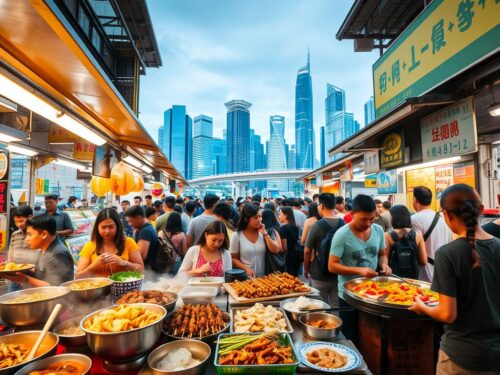Singapore’s culinary heritage is deeply rooted in its vibrant street food culture. Decades ago, vendors served steaming bowls of noodles and fragrant rice dishes from mobile carts. Today, these flavors thrive in UNESCO-listed hawker centers, where generations of cooks perfect their craft.
Hawker centers now house dozens of stalls, each specializing in unique bites. From spicy laksa to savory satay, every dish tells a story. Most meals cost under $10, making it easy to savor diverse flavors without breaking the bank.
Yet, this tradition faces challenges. Many vendors are over 50, with younger generations opting for different careers. The risk of losing this cultural gem adds urgency to experiencing it now.
Key Takeaways
- Singapore’s street food evolved into UNESCO-recognized hawker centers.
- Affordable meals (often under $10) showcase Chinese, Malay, and Indian influences.
- Communal dining is a cornerstone of local culture.
- Aging vendors highlight the need to preserve this heritage.
- Each center offers 100+ stalls with iconic and fusion dishes.
Introduction: Singapore’s Street Food Legacy
Migrant cooks of the 1800s laid the foundation for today’s thriving hawker scene. Chinese, Malay, and Indian vendors sold dishes from pushcarts, blending flavors that still define local cuisine. By the 1970s, the government relocated these vendors into hygienic hawker centers—a move that preserved tradition while modernizing infrastructure.
Today, over 110 centers serve as community hubs. From CEOs to construction workers, locals gather over $3 plates of chicken rice. UNESCO’s 2020 recognition of hawker culture as intangible heritage cemented its global significance.
From Past to Present: Hawker Evolution
| Era | Features | Iconic Dishes |
|---|---|---|
| 1800s–1960s | Mobile carts, open-air stalls | Hainanese chicken rice, char kway teow |
| 1970s–Today | Government-built centers, Michelin stars | Liao Fan’s soya sauce chicken, J2 curry puffs |
Efforts like Hawker Fare train young chefs to continue this legacy. With six centers earning Michelin Bib Gourmand status, the future looks as flavorful as the past.
The Rise of Hawker Centers: A Culinary Revolution
Decades ago, simple pushcarts evolved into bustling hubs of flavor and community. Unlike sterile food courts, hawker centers pulse with heritage—each stall a family legacy. Take Tiong Bahru Market: 83 stalls span two floors, from Jian Bo Shui Kueh’s century-old recipes to Tiong Bahru Pau’s modern twists.
Architecturally, these centers grew from open-air stalls to multi-story complexes. Adam Road (1974) and Maxwell Road (1987) pioneered this shift. Today, their steel beams shelter generations sharing rice bowls drizzled with savory sauce, proving design can nurture tradition.
| Feature | Hawker Centers | Food Courts |
|---|---|---|
| Vendors | Family-run, heritage-focused | Corporate chains |
| Atmosphere | Lively, communal | Standardized, quiet |
| Pricing | $3–$5 per meal | $8–$15 per dish |
These centers feed 80% of locals daily—a testament to their economic role. Hygiene ratings (A/B/C) posted at each stall ensure quality. An “A” grade means spotless prep areas, while “C” prompts retraining. It’s a system that honors both safety and flavor.
From steel carts to UNESCO acclaim, hawker centers are where Singapore’s food culture thrives. Every bite tells a story—one that’s still being written.
The Michelin-Starred: Street Food Goes Global
The world took notice when humble hawker stalls earned Michelin stars. What began as $2.50 plates of chicken rice and vinegar-tossed noodles became global sensations. These dishes proved that excellence needs no white tablecloths.
Soya Sauce Chicken Rice @ Liao Fan Hawker Chan
Chef Chan Hon Meng’s soy-marinated chicken redefined simplicity. His Chinatown stall earned a star in 2016, drawing queues that snaked around blocks. The secret? A 48-hour marinade and steamed rice drizzled with signature sauce.
- From stall to franchise: Expanded to 10 countries, yet the original still serves $4 plates.
- Critics’ debate: Does mass production risk losing the handmade touch?
Gan Mian @ Hill Street Tai Hwa Pork Noodle
At Tai Hwa, 85 years of craft go into every bowl. Their pork-topped noodles balance vinegary tang with chili heat. Patrons wait 40+ minutes—proof that Michelin’s seal honors tradition, not trends.
“The star brought tourists, but our regulars keep us grounded.”
Michelin vs. Bib Gourmand: A Flavorful Divide
While stars spotlight elite vendors, Bib Gourmand celebrates budget-friendly gems. Compare:
| Criteria | Michelin Star | Bib Gourmand |
|---|---|---|
| Price Range | $3–$15 | Under $10 |
| Focus | Innovation | Authenticity |
Both awards share one goal: putting hawker culture on the world stage. For travelers and locals alike, these honors are a delicious invitation to explore.
Old Airport Road Food Center: A Time Capsule of Flavors
Step into Old Airport Road Food Center, and you’re greeted by decades of culinary tradition. Retro signage and worn communal tables tell stories of locals sharing meals since the 1970s. This isn’t just a place to eat—it’s where recipes outlive generations.
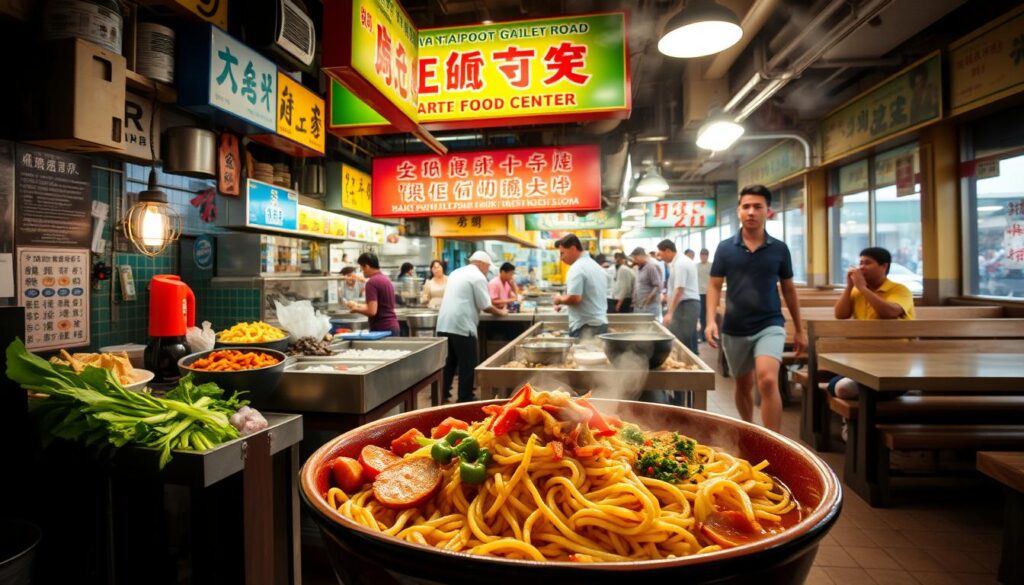
Albert Street Prawn Noodle
Since 1963, this stall has perfected its rich broth by simmering prawn shells and pork bones for eight hours. The result? A bowl of noodles steeped in umami depth, topped with plump seafood and tender meat slices.
Cho Kee Noodle
Open since 1989, Cho Kee dazzles with caramelized BBQ pork crisped to perfection. Their housemade sambal adds a fiery kick to springy noodles, a combo regulars swear by.
Don’t miss Cheng’s Curry Fish Head—a 50-year recipe with turmeric-infused gravy. Pro tip: Skip the 12–2pm lunch rush. Evening brings quieter vibes and golden oyster omelets at adjacent stalls.
Hong Lim Road Food Center: Chinatown’s Hidden Gem
Tucked away in Chinatown, Hong Lim Road Food Center serves up heritage flavors with a side of nostalgia. Built in 1978, it was one of Singapore’s first air-conditioned hawker hubs. Today, its second-floor stalls offer quieter spots to savor legendary dishes.
Ah Heng Curry Chicken Bee Hoon Mee
Since the 1970s, Ah Heng has perfected its curry bee hoon. The dish stars tender chicken simmered in a 12-spice blend. A smoky sambal belacan adds depth to every bite.
Locals swear by the kampong (free-range) poultry, which stays juicy even in the aromatic broth. Pair it with crispy bean curd for texture contrast.
Famous Sungei Road Trishaw Laksa
Sungei Road’s laksa has charmed diners since 1956. Their secret? A broth boiled over charcoal with dried scallops. Fresh cockles, sourced daily, add a briny punch.
- Pro tip: Arrive before 11am to skip the lunch rush.
- Hidden gem: Ji Ji Wanton Noodle’s springy egg noodles.
From fiery curries to umami-rich seafood, Hong Lim Road proves that great flavors need no frills. Its street-side charm keeps regulars coming back—one plate at a time.
Amoy Street Food Center: Where Tradition Meets Innovation
Amoy Street Food Center blends heritage recipes with bold new twists. Nestled in Singapore’s CBD, this hub attracts office workers and food lovers alike. Its stalls mix time-tested flavors with modern techniques, proving hawker culture evolves without losing its soul.
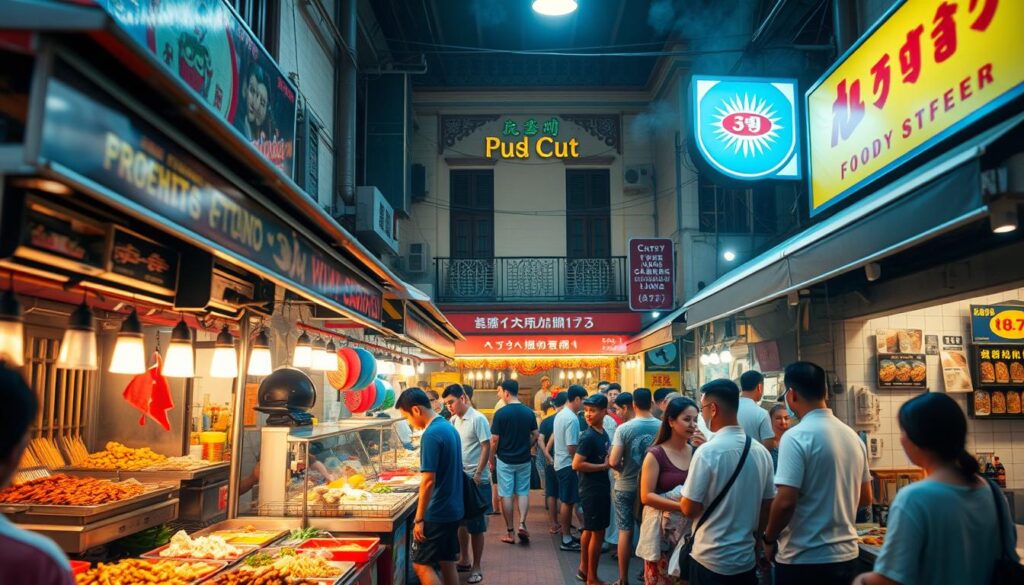
A Noodle Story’s Singapore Ramen
At A Noodle Story, queues stretch for 30 minutes—all for a bowl of fusion noodle magic. Their “Singapore ramen” combines springy egg noodles with potato-wrapped prawns, a playful nod to local and Japanese tastes. The broth, simmered with prawn heads, adds umami depth.
J2 Famous Crispy Curry Puff
J2 reimagines the classic curry puff with flaky, Malay-inspired pastry. Their sardine-curry hybrid packs a spicy kick, while the chicken version stays loyal to traditional flavors. Each bite crumbles perfectly, a testament to decades of craft.
- Tech meets tradition: Young “hawkerpreneurs” use QR codes for orders, speeding up lunch rushes.
- Hidden star: Hoo Kee Rice Dumpling’s bak zhang—glutinous rice wrapped around savory fillings.
- CBD perk: Open until 8pm, ideal for post-work bites.
From reinvented snacks to tech-savvy vendors, Amoy Street proves innovation thrives alongside tradition. Every dish tells a story—one that’s still being written.
Tekka Center: Little India’s Spice Hub
The aroma of cardamom and turmeric fills the air at Tekka Center, a culinary crossroads in Little India. This bustling market blends halal and Hindu flavors, where sizzling pans and fragrant spice racks create a feast for the senses.
Yakader Muslim Food’s Dum Biryani
Since 1985, Yakader has layered basmati rice with tender mutton in a sealed pot (dum style). Their secret? A hint of rose essence in the biryani, adding floral notes to the savory meat. Locals queue for this $6 masterpiece—best paired with cucumber raita.
Shavn-e-Punjab’s Garlic Chili Naan
At Shavn-e-Punjab, tandoor ovens bake naan to blistered perfection. Each piece gets brushed with garlic-ghee chili paste, balancing heat and richness. Pro tip: Order it with dal makhani for a creamy contrast.
- Hidden gem: Tekka Mushroom Minced Meat Noodle’s Teochew-style bak chor mee—a umami bomb with minced pork and mushrooms.
- Market tip: Downstairs vendors sell fresh spices like star anise and cumin for home cooks.
- Cultural note: Halal-certified stalls sit beside Hindu vegetarian options, reflecting Singapore’s harmony.
From rose-scented rice to charcoal-fired bread, Tekka Center proves flavors need no passport. Every bite celebrates the neighborhood’s vibrant roots.
Chicken Rice: Singapore’s National Dish
Few dishes capture Singapore’s culinary identity like its iconic chicken rice. Hainanese immigrants adapted Wenchang chicken in the 1900s, simmering meat in broth and infusing rice with pandan leaves. Today, it’s a national dish celebrated from hawker stalls to Michelin guides.
Tian Tian at Maxwell Food Centre earns fame for its aromatic rice, praised by Anthony Bourdain. Boon Tong Kee’s version shines with 3-hour poached chicken, achieving silky texture. Both prove simplicity breeds mastery.
| Vendor | Style | Signature Touch |
|---|---|---|
| Tian Tian | Traditional | Pandan-infused rice, fiery chili sauce |
| Hawker Chan | Modernized | Soy-marinated chicken, quicker service |
Key elements unite all versions: tender meat, fragrant rice, and tangy chili. Malay nasi ayam adds turmeric rice for a regional twist.
DIY tip: Recreate the magic with ginger-scallion oil. Steam chicken gently, then drizzle with dark soy and homemade chili paste. The result? A taste of Singapore’s soul at home.
Hokkien Mee: A Stir-Fried Symphony
The sizzle of a hot wok and the aroma of garlic and prawns define Singapore’s beloved hokkien mee. This stir-fried dish combines springy noodles with juicy seafood, all kissed by smoky wok hei (breath of the wok).
Two styles dominate: Kuala Lumpur’s dry version and Singapore’s prawn-broth rendition. Locals debate fiercely over which reigns supreme.
| Feature | KL Style | Singapore Style |
|---|---|---|
| Texture | Dry, crispy noodles | Saucy, broth-infused |
| Key Ingredient | Dark soy sauce | Prawn stock |
| Toppings | Pork lard, squid | Prawns, egg strips |
At Nam Sing Hokkien Mee, charcoal-fired woks add depth to every plate. Their 60-year technique ensures noodles absorb the smoky essence perfectly.
- Pro tip: Squeeze calamansi lime to cut through the richness.
- Pairing: Ice-cold barley tea balances the dish’s grease.
- Hidden gem: Golden Mile’s black hokkien mee, tinted with squid ink.
Born from post-WWII noodle surplus, this dish is a testament to Singapore’s resourcefulness. Today, it’s a flavorful bridge between past and present.
Char Kway Teow: The Ultimate Comfort Food
Few dishes blend rich flavors and textures like char kway teow, a hawker staple since the 1930s. Flat rice noodles wok-fried with plump blood cockles, crispy bean sprouts, and caramelized egg create a plate of pure comfort food. Each bite balances smoky, sweet, and savory notes.
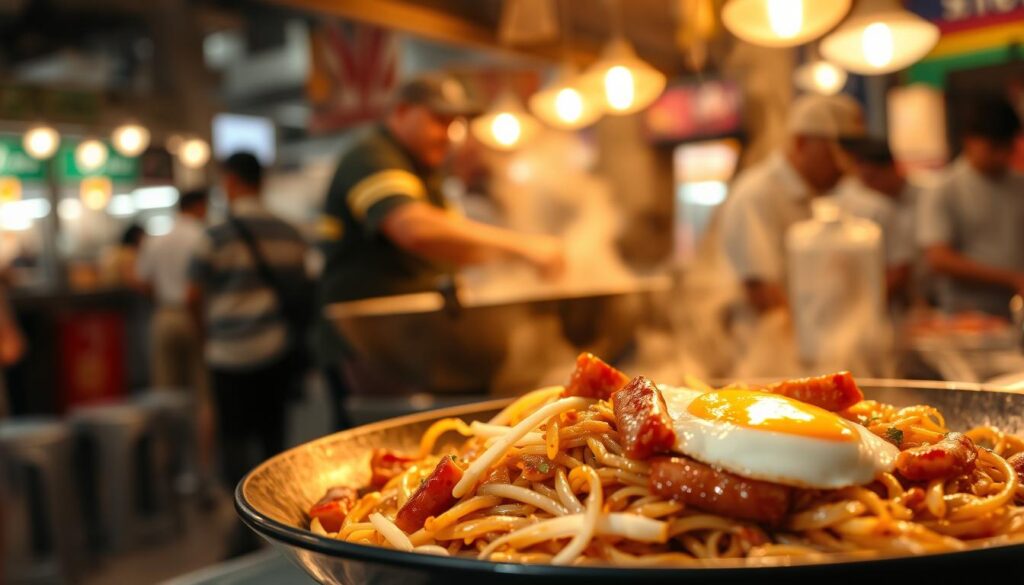
At Outram Park, the recipe leans savory with minimal sugar—a contrast to Penang’s sweeter style. Hill Street’s $4 “black gold” version gets its hue from dark soy sauce. Both rely on pork lard for authenticity, sparking debates about health versus tradition.
- Key ingredients: Lap cheong (Chinese sausage), fresh cockles, and crispy pork lard.
- Pro tip: Ask for “extra spicy” to elevate the dish with house-made sambal.
- Vegan twist: Jin Ji Teochew substitutes lard with mushroom oil and mock seafood.
Whether enjoyed at a bustling center or recreated at home, this plate celebrates Singapore’s culinary ingenuity. It’s a taste of history, one sizzling wok at a time.
Laksa: Singapore’s Spicy Soul in a Bowl
A steaming bowl of laksa is more than a meal—it’s a taste of Singapore’s multicultural soul. This spicy, coconut-rich soup blends Chinese noodles with Malay spices, creating a dish that’s uniquely Peranakan.
At Janggut Laksa, a 1950s recipe shines with dried shrimp and hand-ground rempah paste. Nearby, 328 Katong Laksa serves its noodles cut short—tradition dictates slurping straight from the bowl, no chopsticks needed.
Katong vs. Curry Laksa: The Great Divide
| Feature | Katong Laksa | Curry Laksa |
|---|---|---|
| Broth | Light, tangy | Creamy, coconut-heavy |
| Noodles | Short, slurpable | Long, springy |
| Toppings | Cockles, fish cake | Tofu puffs, chicken |
Customize your plate with extras like otah (grilled fish paste) or extra cockles. For a modern twist, try laksa pesto pasta—a bold fusion of East and West.
“Our rempah paste is ground fresh daily. That’s the secret to depth of flavor.”
Born in Katong’s Peranakan community, this dish is a flavorful bridge between past and present. Whether you prefer it fiery or mild, every bowl celebrates Singapore’s rich culinary tapestry.
Chili Crab: Love It or Hate It?
Few dishes spark as much debate as Singapore’s fiery chili crab. Crack open the shell, and you’ll find tender seafood smothered in a sweet-spicy sauce—a combo that divides diners worldwide.
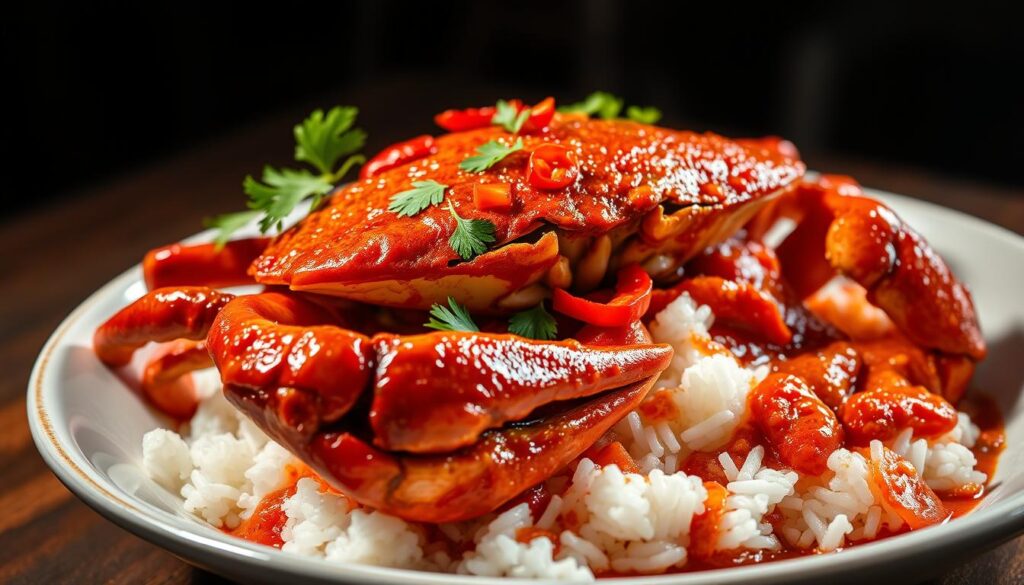
At Red House Seafood, the 1970s recipe rules. Their tomato-chili gravy clings to Sri Lankan crabs, served family-style. Prefer heat without sweetness? No Signboard’s white pepper crab offers a punchy alternative.
- The ritual: Use fried mantou buns to scoop up every drop of sauce.
- Budget note: Market-price crabs can hit $50+—check before ordering.
- Style wars: Chili vs. black pepper vs. salted egg yolk batters.
Locals swear by takeaway to avoid messy shirts. But half the fun is digging in hands-first. Whether you love or hate the sticky fingers, this dish is Singapore on a plate.
Underrated Gems: Carrot Cake and Bak Chor Mee
Not all hawker stars get the spotlight—some shine quietly in local corners. Dishes like carrot cake and bak chor mee offer bold flavors without the tourist crowds. These underrated plates prove Singapore’s culinary depth goes beyond the usual suspects.
At Zion Road, black carrot cake steals the show. Radish cake gets crisped on a hot griddle with sweet soy, egg, and salty preserved radish. The result? A smoky-sweet bite that costs under $4.
For bak chor mee, head to Michelin-recognized Tai Hwa. Their $6 bowl mixes springy noodles with minced pork, liver slices, and a tangy vinegar-chili dressing. Expect 45-minute waits, but every slurp justifies the line.
| Dish | Key Ingredients | Where to Try |
|---|---|---|
| Carrot Cake | Radish cake, egg, chai poh | Zion Road, Bedok XO Sauce version |
| Bak Chor Mee | Pork, vinegar, chili, noodles | Tai Hwa, Ru Ji Kitchen |
Bedok’s Chai Tow Kway adds luxury with XO sauce. Pair it with Teochew porridge for late-night cravings. These dishes may lack fame, but they’re woven into the city’s everyday food tapestry.
Conclusion: Savoring Singapore’s Street Food History
Hawker centers aren’t just eateries—they’re time capsules of tradition and innovation. From 1960s pushcarts to Michelin-starred stalls, each dish carries a piece of Singapore’s history.
Support this legacy by sharing your favorite street food finds online. Join masterclasses like Hungry Tours to dive deeper into the craft behind the wok.
Pro tip: Arrive early, carry cash, and embrace communal seating. These small acts help preserve a culture built on shared meals.
More than a meal, hawker centers are living museums. Every plate invites you to savor stories cooked with pride and passed down through generations.


